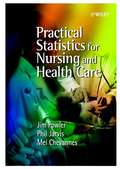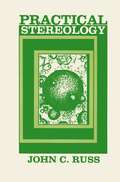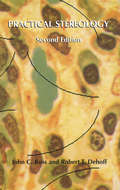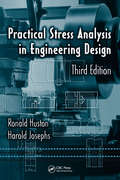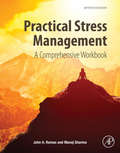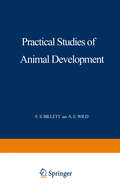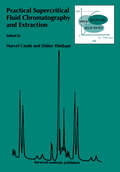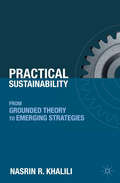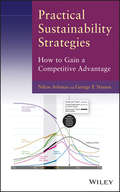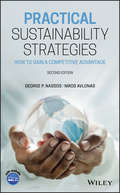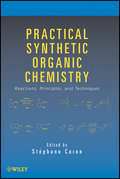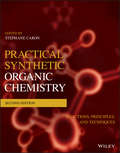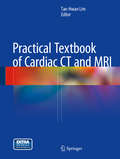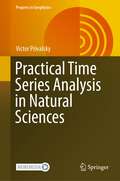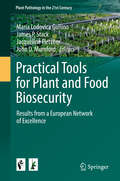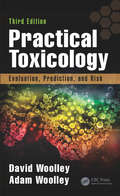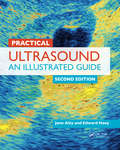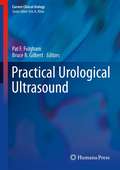- Table View
- List View
Practical Statistics for Nursing and Health Care
by Jim Fowler Phil Jarvis Mel ChevannesNursing is a growing area of higher education, in which anintroduction to statistics is an essential component. There iscurrently a gap in the market for a 'user-friendly' book which iscontextulised and targeted for nursing. Practical Statistics forNursing and Health Care introduces statistical techniques in such away that readers will easily grasp the fundamentals to enable themto gain the confidence and understanding to perform their ownanalysis. It also provides sufficient advice in areas such asclinical trials and epidemiology to enable the reader to criticallyappraise work published in journals such as the Lancet and BritishMedical Journal. * Covers all basic statistical concepts and tests * Is user-friendly - avoids excessive jargon * Includes relevant examples for nurses, including case studies anddata sets * Provides information on further reading * Starts from first principles and progresses step by step * Includes 'advice on' sections for all of the tests described
Practical Statistics for Nursing and Health Care
by Jim Fowler Phil Jarvis Mel ChevannesNursing is a growing area of higher education, in which anintroduction to statistics is an essential component. There iscurrently a gap in the market for a 'user-friendly' book which iscontextulised and targeted for nursing. Practical Statistics forNursing and Health Care introduces statistical techniques in such away that readers will easily grasp the fundamentals to enable themto gain the confidence and understanding to perform their ownanalysis. It also provides sufficient advice in areas such asclinical trials and epidemiology to enable the reader to criticallyappraise work published in journals such as the Lancet and BritishMedical Journal. * Covers all basic statistical concepts and tests * Is user-friendly - avoids excessive jargon * Includes relevant examples for nurses, including case studies anddata sets * Provides information on further reading * Starts from first principles and progresses step by step * Includes 'advice on' sections for all of the tests described
Practical Stereology
by John C. Russvi on geometric probability is included, students can be expected to create a few simple programs like those shown, but for other geometries. I am indebted to Tom Hare for critical reviews of the material and an endless enthusiasm to debate and derive stereological relationships; to John Matzka at Plenum Press for patiently instructing me in the intricacies of typesetting; to Chris Russ for helping to program many of these measurement techniques; and especially to Helen Adams, both for her patience with my creative fever to write yet another book, and for pointing out that the title, which I had intended to contrast to "theoretical stereology," can also be understood as the antonym of "impractical stereology." John C. Russ Raleigh,NC July, 1986 Chapter 1: Statistics 1 Accuracy and precision 1 The mean and standard deviation 5 Distributions 7 Comparison 13 Correlation 18 Nonlinear fitting 19 Chapter 2: Image Types 23 Planar sections 23 Projected images 25 Finite sections 28 Space-filling structures and dispersed phases 29 Types of images and contrast mechanisms 31 Sampling 32 Chapter 3: Manual Methods 35 Volume fraction 35 Surface density 38 Contiguity 41 Mean intercept length 42 Line density 43 Grain size determination 55 Curvature 48 Reticles to aid counting 49 Magnification and units 51 Chapter4: Size Distributions 53 Intercept length in spheres 53 Nonspherical shapes 57 Corrections for finite section thickness 59 Lamellae 61 Measurement of profile size 62 Nonspherical particles 69 vii Contents viii Chapter 5: Computer Metlwds 73
Practical Stereology
by John C. Russ Robert T. DehoffStereology is the science that relates three-dimensional structure to the two-dimensional images that can be measured. The most common field of application is in microscopy, both of man-made materials (metals, ceramics, composites, etc.) and of biological tissue samples. This book covers the applications and terminology of both fields. Recent emphasis in stereology is concerned with sampling strategies to avoid bias due to directionality and non-uniformity, and these methods are fully covered. So are the classic techniques that measure size distributions, surface curvature, etc., which are widely useful but not discussed in other recent texts. Finally, most stereology is taught as manual procedures using counting and grids, but this text also covers the use of modern desktop computers for image analysis and processing to obtain and interpret the stereological data.
Practical Stress Analysis in Engineering Design
by Ronald Huston Harold JosephsUpdated and revised, this book presents the application of engineering design and analysis based on the approach of understanding the physical characteristics of a given problem and then modeling the important aspects of the physical system. This third edition provides coverage of new topics including contact stress analysis, singularity functions,
Practical Stress Management: A Comprehensive Workbook
by John A. Romas Manoj SharmaPractical Stress Management: A Comprehensive Workbook, Seventh Edition, is a focused, personal, worksheet-based text that combines theory and principles with hands-on exercises to help readers manage the negative impact of stress in life. As a practical tool for recognizing and preventing stress, the action-oriented approach enables the student to make personal change through self-reflection and behavior change techniques. This approach allows the book to be used as a text in a course or as a self-study/reference book. In this edition, the authors cover financial stress and expand their section on sleep. The book is accompanied by online MP3 files of guided relaxation techniques and downloadable worksheets. In addition, worksheets and thoughts for reflection boxes help users determine their own level of stress and apply effective stress management techniques.Completely revised, including updated stress management techniques and references, along with further readings in each chapterUpdated websites accompany each chapterIncludes ten new worksheets, along with an updating of remaining worksheetsContains 'thoughts for reflection' boxes that highlight meditation techniques throughout the world
Practical Studies of Animal Development
by F. S. BillettThe purpose of this book is twofold: it is meant to serve both as a practical manual for the study of animal development and as a general introduction to the subject. Central to our en deavour is the belief that developmental biology is best taught and learnt at the laboratory bench, with specimens which are either alive and can be seen to develop or with fresh material derived directly from the egg (as in birds) or mother (as in mammals). Once the dynamic nature of development is appreci ated and the overall structure of the developing organism discerned the more conventional study of sections and whole mounts is more likely to become a delight rather than a diffi cult, and often meaningless, chore. We have laid considerable stress on the early development of animal embryos and the ways in which they can be obtained from a relatively few, but reliable, sources. In addition, emphasis has been placed on fairly simple experiments which make use of the embryos and larvae chosen for the purpose of illustrating develop ment. Embryology ceased to be a descriptive science at the beginning of this century and any practical course, at what ever level, should attempt to reflect this change. It is true that the analysis of development, particularly the genesis of chor date structure, owed much to the invention of the microtome.
Practical Supercritical Fluid Chromatography and Extraction
by Thomas CaudellAn exploration of fundamental as well as practical aspects of supercritical fluid chromatography and extraction. It addresses topics such as: packed columns in SFC; detection in SFC; supercritical fluid chromatography/mass spectroscopy; and evaporative light scattering detection in SFC.
Practical Supercritical Fluid Chromatography and Extraction
by Thomas CaudellAn exploration of fundamental as well as practical aspects of supercritical fluid chromatography and extraction. It addresses topics such as: packed columns in SFC; detection in SFC; supercritical fluid chromatography/mass spectroscopy; and evaporative light scattering detection in SFC.
Practical Sustainability: From Grounded Theory to Emerging Strategies
by N. KhaliliA structured guideline for development and implementation of business strategies, programs, and models with core sustainability values is then proposed and explicitly discussed, drawing upon management models, tools and techniques proven to be effective in organizational decision-making and prognostication.
Practical Sustainability Strategies: How to Gain a Competitive Advantage
by Nikos Avlonas George P. NassosStrategies that enable organizations to succeed as businesses and as responsible corporate citizens Based on the authors' many years of research and hands-on experience, this book provides tested and proven practical strategies that make it possible for organizations to develop, maintain, or extend their competitive advantage without causing harm to the environment and society. Moreover, it explains how to set goals and objectives and then monitor, measure, and report on progress towards achieving corporate social responsibility and environmental sustainability. Most importantly, readers will discover that this can all be accomplished while, at the same time, improving bottom-line profitability. Practical Sustainability Strategies: How to Gain a Competitive Advantage is divided into four parts: Part 1, Introduction to Sustainability, underscores the urgency for organizations to adopt and develop sustainable practices Part 2, Sustainable Strategies, details numerous strategies that have been proven to work, including environmental innovation through biomimicry, green buildings, and green chemistry Part 3, Tools and Metrics, offers practical information on implementing strategies and measuring sustainability and reporting, including global standards and guidelines for managing sustainability, life-cycle analysis, carbon and water footprints such as GRI, GHG Protocol, UN Global Compact Part 4, Conclusion, provides an expert forecast of the future of sustainability Case studies based on the authors' research and fieldwork illustrate how leading companies have implemented each of the sustainability strategies discussed in the book. There's also an appendix with additional case studies exploring various aspects of business practices and sustainability. Practical Sustainability Strategies is ideal as a graduate textbook as well as a reference for business managers. All readers will not only gain a greater appreciation for sustainable development, but also the skills needed to integrate sustainability into all aspects of their organization's business practices.
Practical Sustainability Strategies: How to Gain a Competitive Advantage
by Nikos Avlonas George P. NassosStrategies that enable organizations to succeed as businesses and as responsible corporate citizens Based on the authors' many years of research and hands-on experience, this book provides tested and proven practical strategies that make it possible for organizations to develop, maintain, or extend their competitive advantage without causing harm to the environment and society. Moreover, it explains how to set goals and objectives and then monitor, measure, and report on progress towards achieving corporate social responsibility and environmental sustainability. Most importantly, readers will discover that this can all be accomplished while, at the same time, improving bottom-line profitability. Practical Sustainability Strategies: How to Gain a Competitive Advantage is divided into four parts: Part 1, Introduction to Sustainability, underscores the urgency for organizations to adopt and develop sustainable practices Part 2, Sustainable Strategies, details numerous strategies that have been proven to work, including environmental innovation through biomimicry, green buildings, and green chemistry Part 3, Tools and Metrics, offers practical information on implementing strategies and measuring sustainability and reporting, including global standards and guidelines for managing sustainability, life-cycle analysis, carbon and water footprints such as GRI, GHG Protocol, UN Global Compact Part 4, Conclusion, provides an expert forecast of the future of sustainability Case studies based on the authors' research and fieldwork illustrate how leading companies have implemented each of the sustainability strategies discussed in the book. There's also an appendix with additional case studies exploring various aspects of business practices and sustainability. Practical Sustainability Strategies is ideal as a graduate textbook as well as a reference for business managers. All readers will not only gain a greater appreciation for sustainable development, but also the skills needed to integrate sustainability into all aspects of their organization's business practices.
Practical Sustainability Strategies: How to Gain a Competitive Advantage
by Nikos Avlonas George P. NassosThe guide to sustainable strategies and tools to improve competitive business advantage, updated with practical case studies and supporting teaching material The revised and updated second edition of Practical Sustainability Strategies is filled with proven strategies and tools for organizations to integrate sustainability into their business models. Drawing on the authors’ research and years of hands-on experience, the book defines strategies that organizations can put in place to develop, extend, or maintain competitive advantage without harming the environment. Additionally, the authors provide tools for measuring and reporting progress and present illustrative case studies that clearly demonstrate the importance of implementing sustainability. Since the first edition was published in 2013, new strategies, measurements, and certifications have been developed. The book, which is used by several business schools around the globe, has been updated to include these new and effective strategies, including circular economy, the sharing economy, adaptation, resiliency, and strategies to fight climate change. This new edition also highlights the UN Sustainable Development Goals that have been adopted worldwide. This updated second edition: Covers new strategies, measuring systems, GRI, STARS and B-Lab certifications Offers teaching slides and questions for use in the classroom Explores the principles and importance of sustainability Examines more than 10 different sustainability strategies Presents the economic justification for sustainability with illustrative examples Written for sustainability managers, ESG professionals, engineers, process designers, policy makers, CEOs, business schools, and others, the second edition of Practical Sustainability Strategies offers an updated guide to the most recent strategies and tools that can be put into place to improve competitive advantage, while also providing a positive impact to the community and workplace.
Practical Sustainability Strategies: How to Gain a Competitive Advantage
by Nikos Avlonas George P. NassosThe guide to sustainable strategies and tools to improve competitive business advantage, updated with practical case studies and supporting teaching material The revised and updated second edition of Practical Sustainability Strategies is filled with proven strategies and tools for organizations to integrate sustainability into their business models. Drawing on the authors’ research and years of hands-on experience, the book defines strategies that organizations can put in place to develop, extend, or maintain competitive advantage without harming the environment. Additionally, the authors provide tools for measuring and reporting progress and present illustrative case studies that clearly demonstrate the importance of implementing sustainability. Since the first edition was published in 2013, new strategies, measurements, and certifications have been developed. The book, which is used by several business schools around the globe, has been updated to include these new and effective strategies, including circular economy, the sharing economy, adaptation, resiliency, and strategies to fight climate change. This new edition also highlights the UN Sustainable Development Goals that have been adopted worldwide. This updated second edition: Covers new strategies, measuring systems, GRI, STARS and B-Lab certifications Offers teaching slides and questions for use in the classroom Explores the principles and importance of sustainability Examines more than 10 different sustainability strategies Presents the economic justification for sustainability with illustrative examples Written for sustainability managers, ESG professionals, engineers, process designers, policy makers, CEOs, business schools, and others, the second edition of Practical Sustainability Strategies offers an updated guide to the most recent strategies and tools that can be put into place to improve competitive advantage, while also providing a positive impact to the community and workplace.
Practical Synthetic Organic Chemistry: Reactions, Principles, and Techniques
by Stéphane CaronA hands-on guide to assist in the planning and execution of synthetic reactions in the laboratory Despite the maturity of organic chemistry, it can still be very challenging to identify optimal methods for synthetic transformations that perform as well in real-world manufacturing processes as they do in the laboratory. This detailed and accessible guide attempts to address this vexing issue and deliver proven methodologies practicing synthetic chemists will find valuable for identifying reaction conditions that work reliably over the broadest possible range of substrates. Practical Synthetic Organic Chemistry: Provides a practical guide to strategically planning and executing chemical syntheses for the bench chemist in industry Discusses information that is not common knowledge beyond the boundaries of process chemistry groups, such as the synthetic routes of selected contemporary pharmaceutical drugs and practical solvents, as well as green chemistry concepts Highlights key reactions, including substitutions, additions, eliminations, rearrangements, oxidations, and reductions Addresses basic principles, mechanisms, advantages and disadvantages of the methodology, and techniques for achieving laboratory success Incorporating such an extraordinary wealth of information on organic chemistry and its related fields into one complete volume distinguishes Practical Synthetic Organic Chemistry as an incomparable desktop reference for professionals—and an invaluable study aid for students.
Practical Synthetic Organic Chemistry: Reactions, Principles, and Techniques
by Stéphane CaronA hands-on guide to assist in the planning and execution of synthetic reactions in the laboratory Despite the maturity of organic chemistry, it can still be very challenging to identify optimal methods for synthetic transformations that perform as well in real-world manufacturing processes as they do in the laboratory. This detailed and accessible guide attempts to address this vexing issue and deliver proven methodologies practicing synthetic chemists will find valuable for identifying reaction conditions that work reliably over the broadest possible range of substrates. Practical Synthetic Organic Chemistry: Provides a practical guide to strategically planning and executing chemical syntheses for the bench chemist in industry Discusses information that is not common knowledge beyond the boundaries of process chemistry groups, such as the synthetic routes of selected contemporary pharmaceutical drugs and practical solvents, as well as green chemistry concepts Highlights key reactions, including substitutions, additions, eliminations, rearrangements, oxidations, and reductions Addresses basic principles, mechanisms, advantages and disadvantages of the methodology, and techniques for achieving laboratory success Incorporating such an extraordinary wealth of information on organic chemistry and its related fields into one complete volume distinguishes Practical Synthetic Organic Chemistry as an incomparable desktop reference for professionals—and an invaluable study aid for students.
Practical Synthetic Organic Chemistry: Reactions, Principles, and Techniques
by Stéphane CaronThis book is a hands-on guide for the organic chemist. Focusing on the most reliable and useful reactions, the chapter authors provide the information necessary for a chemist to strategically plan a synthesis, as well as repeat the procedures in the laboratory. Consolidates all the key advances/concepts in one book, covering the most important reactions in organic chemistry, including substitutions, additions, eliminations, rearrangements, oxidations, reductions Highlights the most important reactions, addressing basic principles, advantages/disadvantages of the methodology, mechanism, and techniques for achieving laboratory success Features new content on recent advances in CH activation, photoredox and electrochemistry, continuous chemistry, and application of biocatalysis in synthesis Revamps chapters to include new and additional examples of chemistry that have been demonstrated at a practical scale
Practical Synthetic Organic Chemistry: Reactions, Principles, and Techniques
by Stéphane CaronThis book is a hands-on guide for the organic chemist. Focusing on the most reliable and useful reactions, the chapter authors provide the information necessary for a chemist to strategically plan a synthesis, as well as repeat the procedures in the laboratory. Consolidates all the key advances/concepts in one book, covering the most important reactions in organic chemistry, including substitutions, additions, eliminations, rearrangements, oxidations, reductions Highlights the most important reactions, addressing basic principles, advantages/disadvantages of the methodology, mechanism, and techniques for achieving laboratory success Features new content on recent advances in CH activation, photoredox and electrochemistry, continuous chemistry, and application of biocatalysis in synthesis Revamps chapters to include new and additional examples of chemistry that have been demonstrated at a practical scale
Practical Textbook of Cardiac CT and MRI
by Tae-Hwan LimThis up-to-date textbook comprehensively reviews all aspects of cardiac CT and MRI and demonstrates the value of these techniques in clinical practice. A wide range of applications are considered, including imaging of atherosclerotic and non-atherosclerotic coronary artery disease, coronary revascularization, ischemic heart disease, non-ischemic cardiomyopathy, valvular heart disease, cardiac tumors, and pericardial disease. The numerous high-quality images illustrate how to interpret cardiac CT and MRI correctly for the purposes of diagnosis, treatment planning, and follow-up. Helpful summarizing sections in every chapter will facilitate rapid retrieval of information. This book will be of great value to radiologists and cardiologists seeking a reliable guide to the optimal use of cardiac CT and MRI in real clinical situations.An additional feature is the provision of QR codes allowing internet access to references, further figures, and motion pictures. The reader will be able to enjoy this book using a smartphone or tablet PC.
Practical Time Series Analysis in Natural Sciences (Progress in Geophysics)
by Victor PrivalskyThis book presents an easy-to-use tool for time series analysis and allows the user to concentrate upon studying time series properties rather than upon how to calculate the necessary estimates. The two attached programs provide, in one run of the program, a time and frequency domain description of scalar or multivariate time series approximated with a sequence of autoregressive models of increasing orders. The optimal orders are chosen by five order selection criteria. The results for scalar time series include time domain stochastic difference equations, spectral density estimates, predictability properties, and a forecast of scalar time series based upon the Kolmogorov-Wiener theory. For the bivariate and trivariate time series, the results contain a time domain description with multivariate stochastic difference equations, statistical predictability criterion, and information for calculating feedback and Granger causality properties in the bivariate case. The frequency domain information includes spectral densities, ordinary, multiple, and partial coherence functions, ordinary and multiple coherent spectra, gain, phase, and time lag factors. The programs seem to be unique and using them does not require professional knowledge of theory of random processes. The book contains many examples including three from engineering.
Practical Tools for Plant and Food Biosecurity: Results from a European Network of Excellence (Plant Pathology in the 21st Century #8)
by Maria Lodovica Gullino James P. Stack Jacqueline Fletcher John D. MumfordThis book is based on EU-funded project PLANTFOODSEC, covering intentional and unintentional threats to plant biosecurity and to food safety areas.Biosecurity is a strategic and integrated approach for analysing and managing relevant risks to human, animal and plant life and health, and associated risks to the environment. Interest in biosecurity has risen considerably over the last decade in parallel with the increasing trade in food and plant and animal products; higher levels of international travel; new outbreaks of transboundary diseases.Although most diseases outbreaks have natural causes or are the result of inadvertent introductions of pathogens through human activities, the risk of a deliberate introduction of a high consequence plant pathogen cannot be excluded. Vigilance is required to identify, prevent and manage new and emerging issues that could impact on production capacity, plant biosecurity or food safety and food chain resilience.
Practical Toxicology: Evaluation, Prediction, and Risk, Third Edition
by Adam Woolley David WoolleyPractical Toxicology: Evaluation, Prediction, and Risk, Third Edition shows how to conduct a program of safety evaluation and testing and then to interpret and apply the resulting data and information in the real world, beginning with the basic concepts in toxicology and progressing to the interpretation of the resulting data. Revised and updated chapters on risk assessment guide the reader to setting the foundations necessary for submission to regulatory authorities. In addition, a new chapter in the book reviews the errors in toxicology, mistakes, misuse, mismanagement, and misunderstanding with a view to avoiding these in the future. New Chapters in the Third Edition: Toxicology in silico Errors in Toxicology Safety Assessment of Extractables and Leachables. This new edition follows a practical sequence from introducing the basics of toxicology (including the vital concept of normality in controls) to describing a test program and then interpreting the data and translating that to risk assessment that can be used in a number of real world situations where safety and secure risk assessment are essential. Although written primarily from the perspective of pharmaceutical development, the test designs and toxicological problems encountered in that field are entirely relevant to those with other classes of chemicals, the only difference being the regulatory context. Toxicology is an international discipline and the book has been written to take into account some of the differences in regulatory nuance between the main regions of the world. Completely revised and written in an easily accessible style, the text address several audiences—from students and post-graduates coming to the subject for the first time to established professionals who find themselves needing to learn about toxicology, toxicity testing, interpretation of the results, and risk assessment. It is intended primarily as a textbook, with case studies and information on where to go to ask questions, but can also be used as a practical reference book. It covers all the basics of toxicology and the main aspects of safety evaluation testing and risk assessment while reviewing critically the current state of the discipline. It also provides a foundation for those seeking registration or certification.
Practical Toxicology: Evaluation, Prediction, and Risk, Third Edition
by David Woolley Adam WoolleyPractical Toxicology: Evaluation, Prediction, and Risk, Third Edition shows how to conduct a program of safety evaluation and testing and then to interpret and apply the resulting data and information in the real world, beginning with the basic concepts in toxicology and progressing to the interpretation of the resulting data. Revised and updated chapters on risk assessment guide the reader to setting the foundations necessary for submission to regulatory authorities. In addition, a new chapter in the book reviews the errors in toxicology, mistakes, misuse, mismanagement, and misunderstanding with a view to avoiding these in the future. New Chapters in the Third Edition: Toxicology in silico Errors in Toxicology Safety Assessment of Extractables and Leachables. This new edition follows a practical sequence from introducing the basics of toxicology (including the vital concept of normality in controls) to describing a test program and then interpreting the data and translating that to risk assessment that can be used in a number of real world situations where safety and secure risk assessment are essential. Although written primarily from the perspective of pharmaceutical development, the test designs and toxicological problems encountered in that field are entirely relevant to those with other classes of chemicals, the only difference being the regulatory context. Toxicology is an international discipline and the book has been written to take into account some of the differences in regulatory nuance between the main regions of the world. Completely revised and written in an easily accessible style, the text address several audiences—from students and post-graduates coming to the subject for the first time to established professionals who find themselves needing to learn about toxicology, toxicity testing, interpretation of the results, and risk assessment. It is intended primarily as a textbook, with case studies and information on where to go to ask questions, but can also be used as a practical reference book. It covers all the basics of toxicology and the main aspects of safety evaluation testing and risk assessment while reviewing critically the current state of the discipline. It also provides a foundation for those seeking registration or certification.
Practical Ultrasound: An Illustrated Guide, Second Edition
by Jane Alty Edward HoeyIn the hands of a skilled operator, ultrasound scanning is a simple and easy procedure. However, reaching that level of proficiency can be a long and tedious process. Commended by the British Medical Association, Practical Ultrasound, Second Edition focuses on the scans regularly encountered in a busy ultrasound department and provides everything p
Practical Urological Ultrasound (Current Clinical Urology)
by Pat F. Fulgham and Bruce R. GilbertImaging in medicine has been the primary modality for identification of altered structure due to disease processes. As a non-invasive, safe and relatively inexpensive imaging modality, ultrasound has been embraced by many medical specialties as the ‘go to’ technology. With ever changing technology and regulatory requirements, Practical Urologic Ultrasound provides a compendium of information for the practicing urologist. Written exclusively by clinical urologists, this comprehensive volume features original research on the basic science of ultrasound and explores all aspects of the subject, beginning with the physical science of ultrasound and continuing through clinical applications in urology.Bolstered with detailed illustrations and contributions from experts in the field, Practical Urologic Ultrasound is an authoritative and practical reference for all urologists in their mission to provide excellence in patient care.
